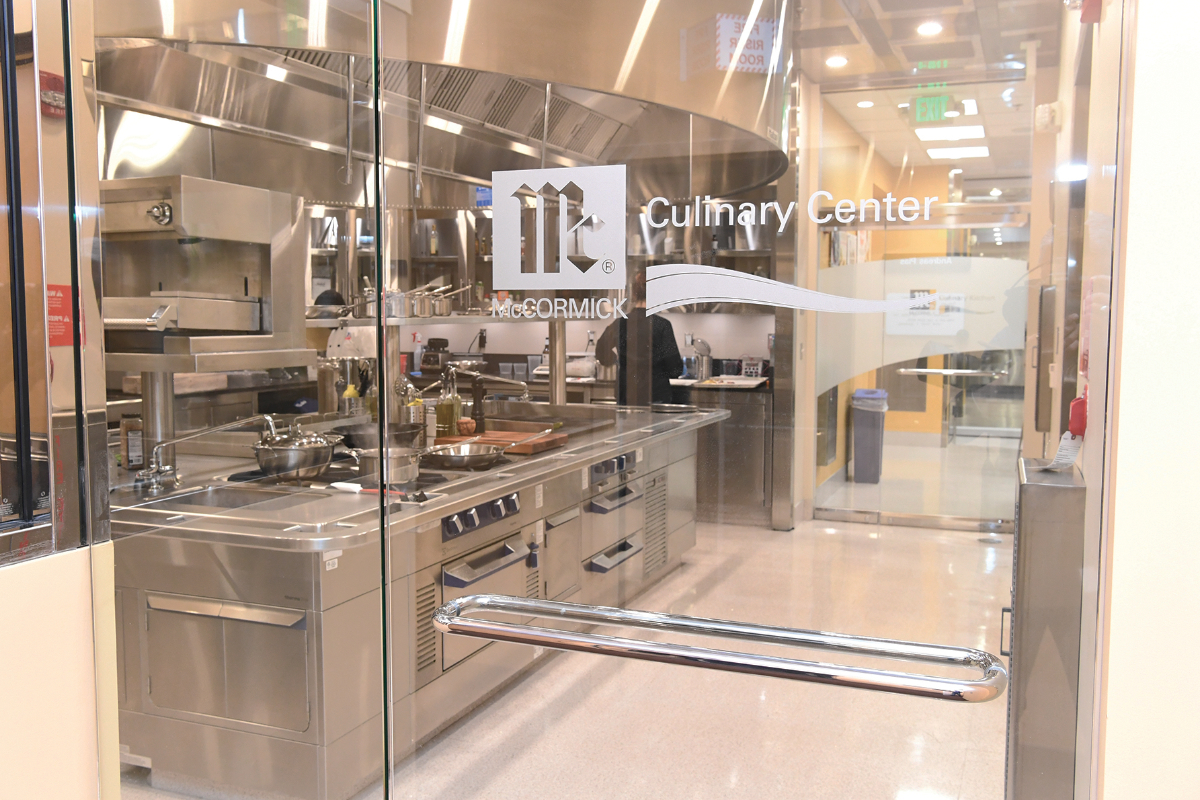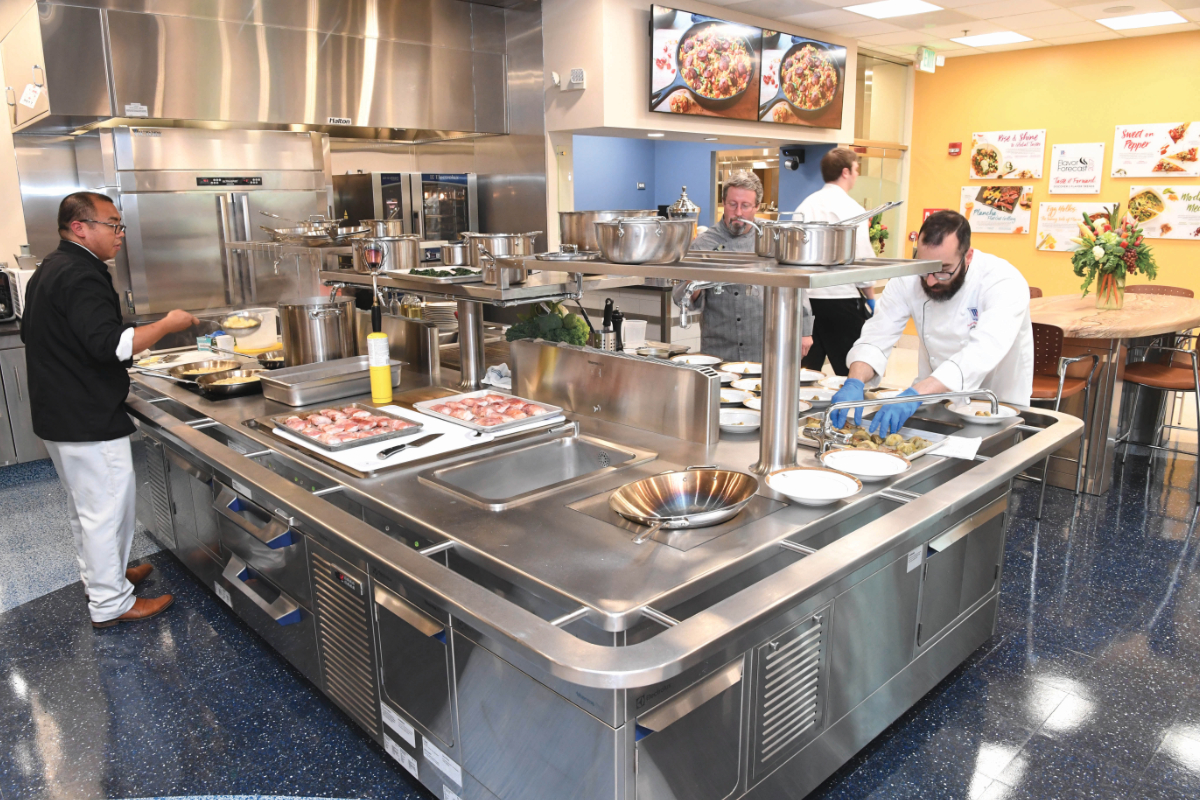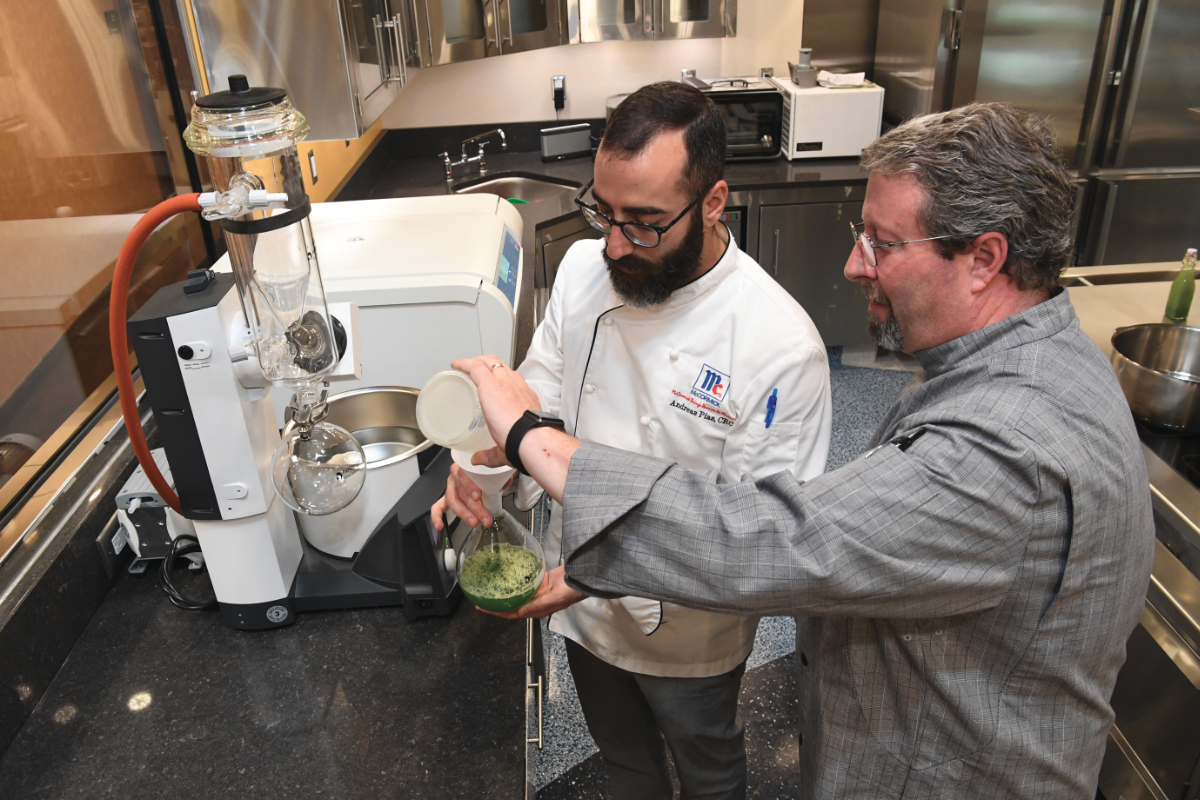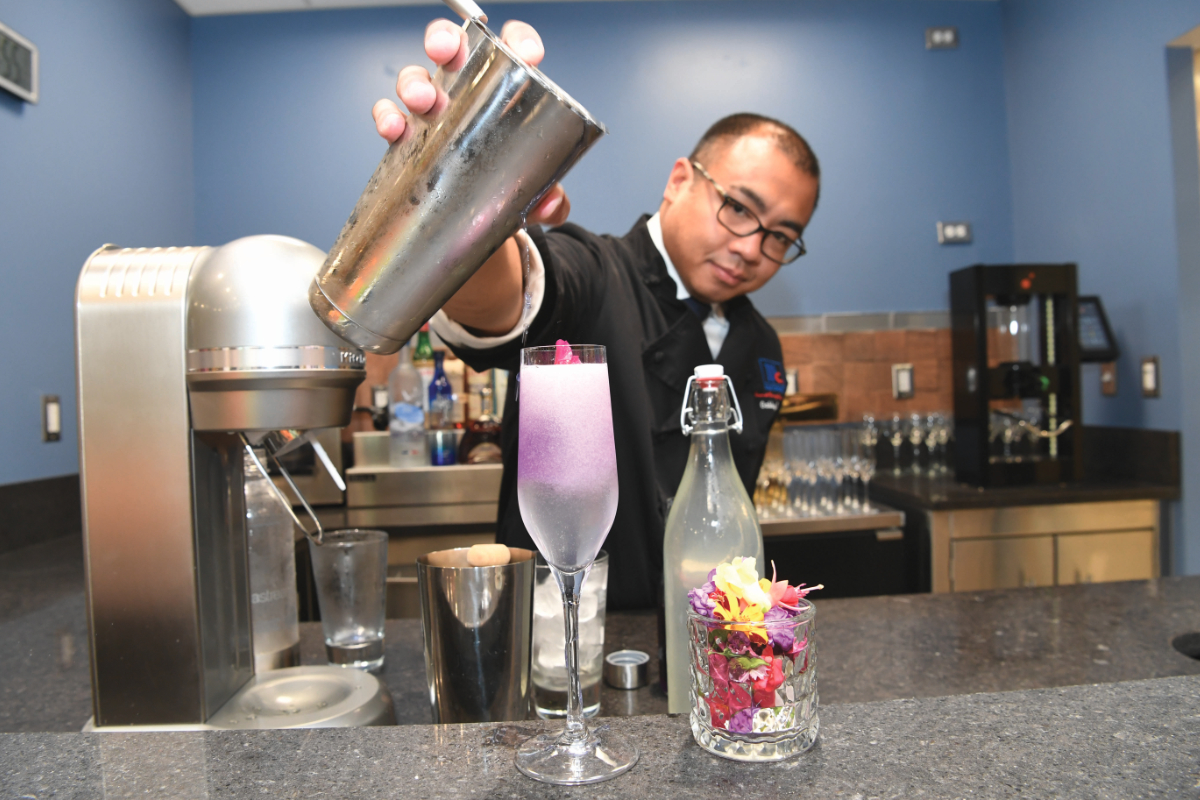HUNT VALLEY, Md. — Walking through McCormick & Co.’s Culinary Innovation Center is to experience the 130-year-old company’s vision of the future of food and beverage research and development: a vision that incorporates the latest science, technology, collaboration and a bit of storytelling.
The center opened in the spring of 2017, seven months after renovation began.
“This was an opportunity for us to be smarter,” said Gary Patterson, CEC, executive research chef and director of culinary science for McCormick.
Patterson led the development of the new center.
“As we were designing it, the intent was to create something better than anything else out there,” he said. “I wasn’t looking to do what anyone else was doing today … I’m looking down the road.”
Initially, the project’s budget covered infrastructure upgrades including improved drainage, data lines and the HVAC system. But the chef had bigger ideas for the 3,000-sq.-ft. space and sold management on his plan for what he calls the "Kitchen of the Future” — a space that could inspire the company — and its customers — for years to come.
A food-first approach is part of McCormick's CEO Lawrence Kurzius’ strategy for the company, so the pitch to invest heavily in an innovation center aligned with his goals for the company. McCormick is known for its red-capped brand of spices, but it also owns such brands as Zatarain’s, Lawry’s, Thai Kitchen, Stubbs and Old Bay, and the company recently acquired Frank’s RedHot and French’s mustard, adding to its portfolio of regional and global flavor profiles.
“We are a global food company, and Lawrence saw this center as a great way forward to show a point of differentiation,” Patterson said.

The business of innovation
By investing in next-generation culinary technology and creating a work environment that fosters collaboration, McCormick has created a place that aligns well with evolving customer needs. The upgraded food service equipment and a suite of audio-visual components help the team connect on-demand with internal and external customers. The center provides a space for collaboration, blue sky thinking and rapid prototyping.
“When you see an infrastructure that’s been put in place, it gives the customer confidence that, one, you understand their business, and two, you’re committed to finding solutions that are relevant to them,” said Brian Jorgensen, marketing manager for category and insights at McCormick. "By extension, it accelerates the product/project life cycle a little because they can see that you have a commitment to strategy and the resources in place to enable their growth.”
Patterson's team works to ensure they’re effective partners to both internal and external customers. The renovated center was designed to reflect that philosophy.
“We project a positive, optimistic, enthusiastic approach to everything we do," he said. "That has created an environment where people want to share. As a result of increasingly sophisticated consumer preferences and higher expectations of the taste experience, it is now in vogue throughout the industry to have culinary engaged in the product development process."
Culinary has always been an intrinsic part of the development process at McCormick, Patterson said.
“Our new culinary center brings new energy and technology to our long-standing collaborative flavor creation process and ensures we are able to help our customers succeed in a rapidly evolving market," he said. "I’ve got the same culinary team that was here before … but at the end of the day, yes, we could have done this work with the old kitchen and people would have said, ‘You have amazing chefs,’ and that’s what they would have walked away with. But we’re not the story. McCormick is the story.”
Having led culinary teams and restaurant openings for The Walt Disney Company for 22 years before joining McCormick in 2010 and understanding the fit and finish of a space, Patterson had the experience to design a world-class kitchen and apply a storytelling aspect.
“Culinary gives our company the ability to convey a message through food,” he said. “We do tell a story every time we make a meal … What’s the purpose? How does this inspire? I make sure we’re always trying to convey a message."

Tools for tomorrow
What does the kitchen of the future look like? McCormick’s center has three kitchen spaces: the innovation kitchen, where core cooking happens; the Kitchen of Tomorrow, which features cutting-edge tools and a mini-greenhouse; and the demonstration kitchen, outfitted as a conference room with the latest audio-visual equipment. Plus, there are four supporting areas: a mixology bar; a traditional meeting room that can open to the demonstration kitchen; a video technology room; and the dish/storage room.
The new center has the same footprint of about 3,000 sq. ft. as the original center, but Patterson was able to increase the usable square footage by about 40 percent with a few design tricks. The previous space housed desks and a 20- by 60-sq.-ft. dry storage area with standard rolling metro-style ventilated shelving. Because he couldn't gain more floor space, he focused on maximizing the footprint vertically.
“We were able to tuck that [storage area] away so that it’s still centrally located to the kitchen, but not right in the center of it,” he said.
Now a compact 12- by 10-sq.-ft. space houses a Kardex brand elevator storage system with vertical, rotating storage.
Patterson found a like-minded partner in Electrolux, a company that invests a portion of profits back into R&D.
“It struck a chord with me that I could build a relationship with them so that as they create new technology, we would have a connection with them.”
Overall, the center is home to an induction suite (the chef believes the energy-saving technology will have higher consumer penetration in the future), an aqua cooker for sous vide-cooking techniques, a pressure braiser that reduces the time to make stock/broth, a refrigerated centrifuge and a rotary evaporator. McCormick is exploring other technologies, as well, including 3-D printing.
“We used to say that baking is a science and cooking is an art," Patterson said. "Well, it’s all science. If we can take that precision cooking and create recipes that can be very precise ... We can create recipes for them that they can execute on. I can write a recipe that anyone can reproduce — with the same technology and equipment.”
Within the same building as the innovation center is where “everything R&D within McCormick US happens," Patterson said. The company’s seasoning labs, sensory labs and a consumer-facing kitchen are an elevator ride away.
“The Culinary Innovation Center is part of a tool kit, if you will. Culinary is not the end all be all, but it’s part of a larger painter’s palette. It takes all of it to make the whole thing work well together.”

Making connections
“It’s not easy being a global company,” Patterson said. “You’ve got to lay a good foundational groundwork. It takes time to find those winning ways of working.”
With research chefs based throughout the world, Patterson said he is constantly wondering how the team may better connect globally. For both external and internal customers, he feels physical presence should not be a barrier.
The center’s video system features an integrated Tricaster brand system for live broadcasting and video conferencing that allows for cooking demonstrations and consultations regardless of time and travel hurdles. While some video tech support is required, the amount is significantly decreased and allows the team to reach their audience quickly.
“Ultimately that kind of technology is going to help us stay better connected,” he said.
Large monitors make it easy to stream or share content with others on demand, and tracking cameras can follow a chef around in the kitchen, keeping the chef in the frame of the camera at all times.
“The intent is to be able to connect not just with our global culinary team, but to be able to connect with customers who are coming in to work with us," Patterson said. "If their team can’t come in or it just doesn’t make sense from a financial standpoint, they can still participate.”
One way the culinary team works to inspire customers is through the company’s annual trends report, The McCormick Flavor Forecast, which has been published since 2000. The report has traditionally existed as a combination of print materials and presentations supported by in-person cooking demonstrations, but with the new video system Patterson’s team can offer live feed demonstrations that show off the chefs’ personal excitement for the trends regardless of physical limitations.
“It connects all of the dots and it makes it real," he said. "At the end of the day that’s what it truly does. My team just really enjoys cooking, creating and inspiring what the next new big thing is, whether that’s for a customer or that’s through trends associated with the Flavor Forecast.”
The center’s core culinary team has embraced the inspirational mindset. Rachel Gooding, research chef, designed custom dishware for the center; Andreas Pias, CRC, senior research chef/culinary nutrition, guides the most innovative projects in molecular gastronomy; and Len King, senior research chef, CEC, CRC, helps to translate what is happening in the center to McCormick’s customers.
“My team has the best job, because what we do is we set the stage for the rest of our business to be successful,” Patterson said. “It really gives us a broad reach as far as being a global flavor company.”

Mixology matters
“From a chef’s standpoint, we create winning proofs of concept and we tell stories through food,” Patterson said.
When redesigning McCormick's Culinary Innovation Center, he made room for a culinary mixology station that serves as the heart of the innovation kitchen area. A bar where his team may brew, shake and stir solutions inspired by the latest flavor trends, he thought, would place that same passion for food through the creative lens of mixology and may inspire winning applications for customers.
McCormick’s senior research chef and culinary mixologist Gabby Quintana led the vision for a fully-equipped mixology kitchen that explores the layered flavors of craft cocktails, mocktails, shakes, coffees, teas and other sophisticated sips. The bar features a vacuum extractor, roto evaporator, carbonation and nitro systems, microbrew systems for fermented drinks and a refrigerated centrifuge for making concentrates, in addition to the latest barista ware.
“It’s worked enormously well for us,” Patterson said of the mixology kitchen, which has become a favored spot for creating memorable experiences for customers, focus groups and other visitors. “We’re really looking to push the edge."
A customer was recently treated to one of Chef Quintana’s inventions, a deconstructed tiramisu made with a housemade, nitrogen-flushed cold brew coffee that was aged in a charred oak barrel that previously had held a local rye whiskey.
“When [the customer] had it, they were just blown away," Patterson said.
Beverages now play an elevated role in the consumer taste experience, Jorgensen said.
“It’s no secret that meal occasions have changed,” he said, and beverages are now a top of mind as a snack.
“Historically the food component has reigned supreme from a customer engagement perspective,” Jorgensen said. “But sometimes the greatest inspiration is right in front of you, and sometimes you need a chef like Gary or Gabby to bring it to life.”


